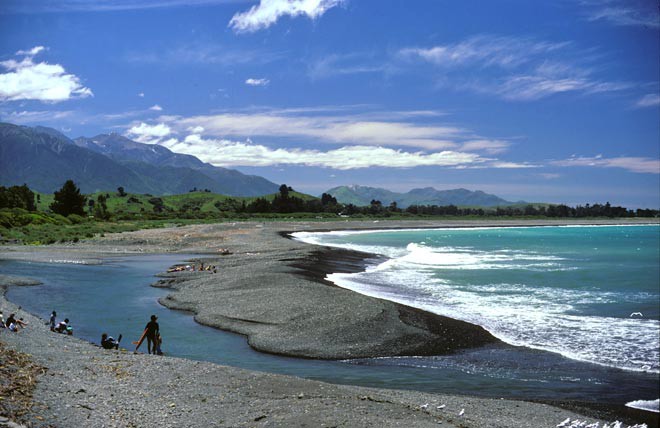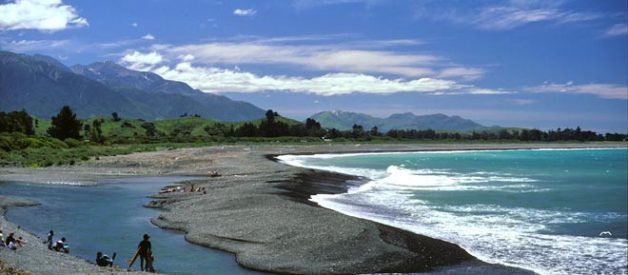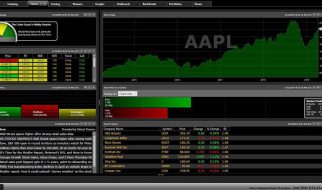Coast, coastline, shore, and shoreline. These terms are often found together. They all describe the area where the land meets the sea or the ocean, but what do they mean? What?s the difference between the coastline and shoreline?

The coastline vs. the shoreline
The shoreline describes the edge of the shore ? the stretch of dry land that is right next to the body of water. Essentially, the shoreline is where the beach ends. The precise position of the shoreline can change depending on the tides.
The coastline also refers to the shoreline, but it?s more technically specific. The coastline refers to the boundary where an island or continent ends. This is described as the end of the continental plate. In simpler terms, the coastline is the boundary of the continent/island, while the shoreline is the boundary of the land.
Also known as the coast or the seashore, the coastline describes the area where the land meets the sea or the ocean. Specifically, it?s the line that separates these two types of geographical features. The term is also applicable to the area where a lake meets the land. The precise line that describes the coastline and shoreline cannot be determined due to the coastline paradox, caused by the fractal geometrical properties of the coast.
Coastline formation
One of the most important factors in coastline formation are tides. They determine the range over which sediment is eroded or deposited. High tidal areas allow waves to go further across the land, while areas with smaller tides create deposition areas at smaller elevations. Erosion is also created by tidal bores that create and expand estuaries.
Waves are important erosion factors for all coastlines. Depending on their force, they can move more or fewer sediments. Wider coastlines have more room to help wave energy disperse and the erosion is less present. On the other hand, coastlines that have cliffs have less room for wave energy dispersal and the erosion is higher. The water is forced into fissures and cracks and the rocks are broken apart in time.
The sediment is also deposited by rivers. The riverine deposition is affected by human intervention via dams or other regulatory devices. Coasts are generally dynamic geographical features, and their shape, size, morphology and appearance change over time depending on many factors. Natural processes, like the sea level rising, weather phenomena, and other external factors create erosion, accretion and reshaping of coasts over millions of years.
The environmental importance of coastlines
Coastlines are extremely important parts of the ecosystem because they bring together fresh and saltwater in close proximity to dry land. These areas provide a diverse range of nutrients for both marine and land life. Other animals and plants are present in the coastline area, supporting its immense biodiversity. Because of these factors and elements, the coastline is also extremely important for human activity for thousands of years.
Human use of the coastline and shoreline area
The coastline is inhabited by people for thousands of years. A lot of major cities are located near or on the shoreline of the world?s oceans and seas. The cities have important port and harbor facilities built in the immediate coastline area. The coastline is also an important borderline, and humans have defended this important geographical feature against invaders, smugglers, and illegal immigration. For this purpose, many coastlines have massive coastal shoreline defense buildings and military equipment that defend inhabited areas.
Human threats to coastlines
The coastal shoreline is susceptible to multiple human-induced threats. These threats are scientifically known as ?human-induced environmental impacts? and are studied by geographers and environmentalists across the world. Some of the most important threats are the rising sea levels (according to some theories caused by human activity and pollution), pollution and fishing.
Pollution ? pollution along the coastlines is widespread in almost every country. Pollution refers to the garbage and industrial debris, petroleum and related products transportation in oil tankers, oil spills, and small spills caused by small vessels that are active near the beach. These factors can damage the coastline directly, affecting both the fauna and flora in the area.
Fishing ? this activity has damaged the coastline, especially in overpopulated areas. Fishing can negatively impact the coastline via habitat degradation, trawling, overfishing, bycatch and climate change. Nearly every fishery can damage the coastline with pollution and ocean scraping, which destroys corals, reefs, and sponges, which need more time to recover. The negative impact of fishing can damage the ecosystem irremediably and destroy the biodiversity of the area. Bycatch, for shrimp, (catching other species of fish when fishing), is five-time larger than the actual shrimp capture.
Types of coastlines
Emergent and submergent coastlines ? Emergent coastlines experienced a fall in sea level, because of local uplift or a global sea-level change. Submergent coastlines are coastlines that experienced a rise in sea levels.
Concordant and discordant coastlines ? concordant coastlines feature various types of rocks on the shore, forming beaches, coves, and cliffs. Discordant coastlines feature rocks that are susceptible to erosion, thus forming bays, inlets, outcroppings, and headlands.
Flat coasts ? the land gradually descends into the sea and beaches are common
Graded shorelines ? the wind and the water has created a straight, flat
coastal shoreline ? wide beaches are common
Cliffed coastlines ? also knowns as an abrasion coast, it features steep declivities with hard rocks, known as cliffs
Cliff erosions
Sediment ? Sediment is deposited along the cliff after sea cliffs are eroded by the waves or the wind Sea caves ? These are created when the rocks aren?t contiguous and softer rock is eroded in time; the crevice created evolves into a cave. Stacks ? Stacks are headlands which were eroded in time by the wind or the waves Stump ? Stumps are stacks that have disintegrated and fallen after extended erosion
Wave-cut platforms ? They form after the erosion of the cliff has been active for a long time. The platforms will retreat as the erosion expands and they will be more stable, as the waves lose energy.


